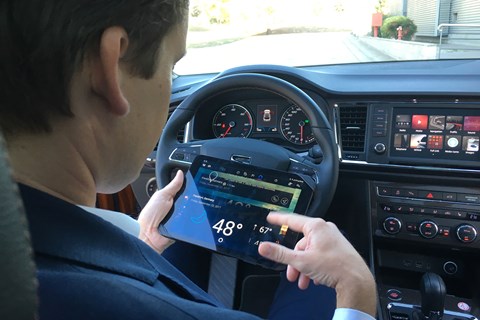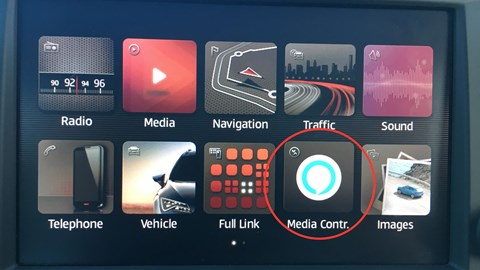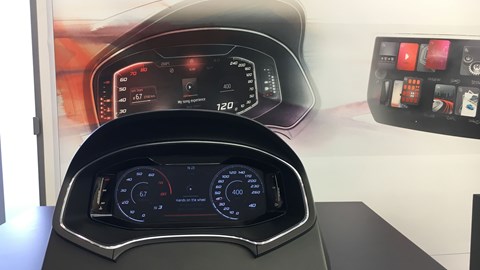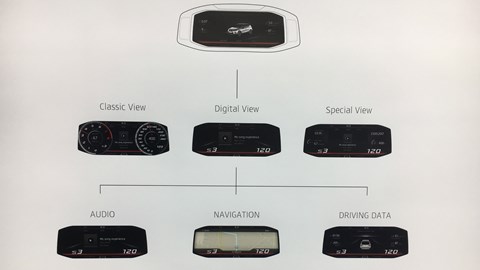► Seat starts rolling out Alexa in cars
► We test Amazon Alexa in a Seat Ateca
► How the digital voice assistant works
Herbie the VW Beetle, Pontiac Trans-Am K.I.T.T. and now Seat’s Ateca and Leon – the age of having a free-form chat with your car and getting a sensible answer intensifies from summer 2018. Seat has begun the roll-out of Amazon’s digital assistant Alexa: until now trapped in Echo home units, soon free to take road trips with you.
Alexa is designed to boost safety by carrying out commands while you keep your eyes on the road and hands on the wheel, as well as make journeys more entertaining. CAR magazine flew to Barcelona to test it on the roads around the Martorell factory. Here’s how we got on.
1. Talk us through a conversation with Alexa…
Voice control is commonplace in today’s cars, but many systems suffer from limited capabilities and often require you to stick to scripted commands. Not with Alexa. Simply double press the steering’s volume click wheel to hear Alexa’s chime of readiness, then make your request. Here’s how one conversation played out.

‘Ask my SEAT to look for a restaurant?’
ALEXA: ‘Do you want to search a restaurant at your current location or in a specific city?’
‘Current location.’
ALEXA: ‘I found a restaurant,’ she responds, reading out a name and address in Martorell. ‘Do you want to set navigation to that place, call it, or search more?’
‘Set navigation’
ALEXA: ‘Please confirm that you want to go to this place on your navigation system.’
As if by magic the Seat navigation system flashes up the address, and a press of start guidance calculates your route.
Requesting the weather in London, checking events in your Google calendar, asking who Barack Obama is or for Alexa to play music – Amazon’s digital assistant correctly understood all those tasks and responded usefully. The only snafu was when I asked Alexa to ‘take me to my nearest Seat dealership’ and it responded with a Kia dealership in Martorell – ah…

2. How has Seat made it work?
Seat is immensely proud of being the first European car maker to integrate Alexa into its cars, and reckons its application could be the world’s best. And the Spaniards will have taken it from intent to production in six months – one hell of an achievement, given car industry advances are typically measured in years.
Initially the firm considered installing an Echo base unit in the car, but soon realised that it wouldn’t meet temperature or vibration demands. ‘The door into the car’ was, according to chief digital officer Fabian Simmer, Seat’s media control app, which enables car occupants to stream music or send a navigation destination to the main infotainment unit. Simply download the Alexa app onto your mobile device and connect it to the head unit via Bluetooth, and you can talk to Amazon’s digital assistant via the in-car microphone and speakers.
3. How much will it cost and which devices are compatible?
You’ll need to upgrade to the highest-grade navigation system with Wi-Fi connectivity, which costs £935 on an Ateca FR or Excellence and £705-955 on a Leon, depending on trim level. Other than that, there’s no Seat cost, as you’re effectively using the app on your smartphone. But you will drain data from your device provider. ‘You’re using data only when asking Alexa something, not all the time clicking the button, so it’s very limited [usage],’ says Simmer. And people are used to streaming songs in cars on their data package, using apps such as Spotify.
Services are now available in the UK on model year 2019 Leon and Ateca models equipped with navigation, via the Android Seat Media Control with Amazon Alexa app. Owners download Seat Media Control with Amazon Alexa from the Android PlayStore, connect it to the vehicle and the voice service is ready to use. It will be rolled out to further models in the coming months.
4. What’s the user experience like?
It’s pretty much identical to using Echo at home, although you don’t have to say ‘Alexa’ to activate the unit – it’s all down to that press of the mute button. The Echo records your message, transmits it to the cloud where it is turned into a text request, then the system either searches the web or uses one of the apps you’ve activated in the Alexa ecosystem – or ‘skills’ in Amazon parlance – to carry out a function. You’re at the mercy of your 4G mobile connection though.
If you’re a Domino’s Pizza app user, and you’ll be able to verbally order a pizza, then race the delivery driver to get home to accept it. Or, if your home is connected and you have an Internet of Things-enabled door and a positive view of humanity, you’ll be able to let the pizza-conveyor leave it in the hallway.
‘I think the really cool thing is the connected home stuff,’ says chief digital officer Simmer. ‘My in-laws have a house in the Pyrenees. We always have to call somebody to go into the house to put the heating on in winter, so it’s warm when we arrive. Instead we could say “Alexa put the heating system on”. You’re also able to make a grocery list in the car.’
Like Alexa at home, the system is purely vocal. While the Ateca with its protoype system has an Alexa icon on the infotainment homepage, this won’t be on the production car because not everyone will have this capability in their Seat.

5. Which unique skills has Seat developed?
Our attempt to locate a Seat dealership via an Alexa web search failed, but if you use the command ‘ask my Seat to…’ you can tap into skills specially developed by the Spanish car maker. Saying ‘ask my Seat to look for a dealer’ enables you to find one in your current location, a specific city or at your destination. Seat has hooked up its dealer database with Alexa’s back end to realise this. More Seat skills will be revealed as the device is rolled out in December.
The brand believes developments such as Alexa are critical, because its customer base is around 10 years younger than rivals, and these ‘digital natives’ might be less tolerant of interruptions to their online existence. ‘We have a relationship with Google, Apple…Waze. And now we have Alexa,’ says Simmer. ‘These guys have seen that, even though Seat sold 410,000 cars last year, they get faster development with us and can use it across VW group, suddenly going from 410k to 10.2m cars a year.’
So drivers of other VW group brands should stand by their beds, advises Simmer. ‘Once we send Alexa out, from then on everybody is free to use it – but they’ll have to adapt it to their specific use cases.’ Forget Herbie, it’s Seat going bananas for Alexa.
New digital instrument pack – another advance for Seat
Seat also gave us a glimpse of its digital instrument cluster, available on the Arona and Ibiza from early 2018. Introduced to some fanfare on the Audi TT, Seat’s adaptive binnacle uses a 10-inch screen and know-how from Volkswagen’s similar system, although it gets bespoke graphics by Martorell’s visual design team.

Using a ‘view’ button on the steering wheel, owners will be able to cycle through three modes:
• Classic – with familiar ‘analogue’ speedo and tacho dials rendered digitally
• Digital – with more information and simple, numerical display of speed and selected gear
• Special – where you can call up vehicle data too
Owners will also be able to pull in full-screen navigation in their eyeline, or audio, phone or driving data. The digital cluster, which will be a cost option, will be rolled out to Leon and Ateca in 2018 too.
